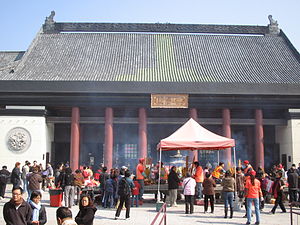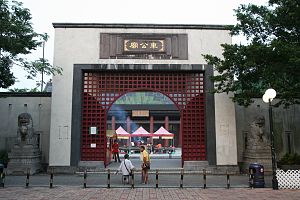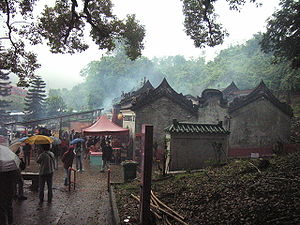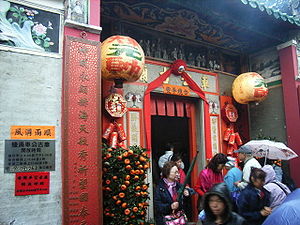- Che Kung Miu
-
Che Kung Miu (Chinese: 車公廟; pinyin: Chēgōng Miào), also called Che Kung Temple, are the temples for Che Kung (車公), who was a general during the Southern Song Dynasty (1127-1279) in ancient China. He is believed by some worshipers to have been involved in the attempt to keep the Song state alive by bringing Prince Ping and his brother to the South.[1] There are two temples dedicated to Che Kung in Hong Kong: one in Sha Tin and one in Ho Chung.[2][3] Other temples in Hong Kong are partly dedicated to Che Kung.
Contents
Sha Tin
The Che Kung Miu near Tai Wai, in Sha Tin District, New Territories, is the most famous one in Hong Kong. During the second and the third days of Lunar New Year, thousands of people go to this temple to worship, including many local Hong Kong government officials. This temple, on Che Kung Miu Road, is located midway between Tai Wai and Che Kung Temple stations of the MTR.[4][5]
The original temple was first built at the end of the Ming Dynasty (1368-1644) and was renovated 1890,[4] 1993 and 2004. The external walls are now plastered with false brick lines and the roofs with green glazed ceramic tiles. The recent renovation is considered to have "very much diminished the authenticity of temple".[6] Due to the high number of worshipers during the Che Kung Festival following the Lunar New Year, a new temple was built in 1994 in front of the original one.[4] The original temple has been preserved in-situ; it is only occasionally open to the public.[6] It is classified as a Grade II historic building[7] since 1987.[6]
The current Che Kung temple, in Japanese-style,[8] was built in 1993-1994 at a cost of HK$48 million.[4] It is eight times the size of the old one.[6] The main hall contains a giant statue of Che Kung. Next to it is a fan-bladed wheel of fortune, which, worshippers believe, will bring good luck when turned three times. Fortune-tellers can be found within the temple.[5]
The temple is administered by the Chinese Temples Committee since 1936.[6] Admission to the temple is free, but it is customary for visitors to donate money to support the maintenance of the temple. Its opening hours are 7:00am to 6:00pm daily.[4]
Ho Chung
Situated on the banks of the Ho Chung River,[9] and half a mile from Ho Chung Village (蠔涌) of Sai Kung District,[10] the temple is one of the oldest in Hong Kong. Initially built in the mid-16th century, the temple predates its popular counterpart near Tai Wai in Sha Tin. The present temple structure probably dates largely from 1878, while the temple furniture probably dates from the Xianfeng era (1850-1861).[10]
It is great place to be for Chinese New Year, as the spirit of Che Kung is celebrated alongside memories of family members that have passed to the next life.
Other deities worshipped at the temple include Hung Shing, Tin Hau and Choi Pak Shing Kun (財帛星君).[3]
Run by villagers for over 300 years, the temple is now being kept by Wan Sai Cheung of the Wan family[citation needed] who have been residents in Ho Chung village for many generations. It is listed as a Grade II historic building[7] since 1996.[3] The temple has been renovated several times. It is considered that "the authenticity [of the building] is in general kept". Known renovation dates include 1908, 1994 and 2002,[3] while other sources also mention 1934 and 2000.[10]
Other temples
Other temples in Hong Kong are partly dedicated to Che Kung. These include:
- I Shing Temple (二聖宮), in Tung Tau Wai (東頭圍), Wang Chau. Built in 1718, it is dedicated to Hung Shing and Che Kung.[11] It was declared a monument in June 1996.[12]
- In the Chung Shing Temple (眾聖宮, "Temple of All Saints"), in Wing Lung Wai, Kam Tin, eleven deities are worshiped, including Kwun Yam, Hung Shing and Che Kung.[13]
Festivals
There are four annual Che Kung Festivals (車公誕):[4]
- 2nd day of the first lunar month, the most popular,[6] is Che Kung's birthday.[8] People come to the temple to worship Che Kung, turn fan-bladed wheels of fortune[14] and beat the drum to ensure good luck in the coming year. About 100,000 people visit the Tai Wai Temple at this time of the year.[15] Crowd management and traffic arrangements are implemented each year during the festival.[16][17]
- 27th day of the third lunar month
- 6th day of the sixth lunar month
- 16th day of the eighth lunar month
See also
References
- ^ The Historical Heritage of Ho Chung, Pak Kong, and Sha Kok Mei, Sai Kung. p5
- ^ Antiquities and Monuments Offices - Introduction to 1444 Historic Buildings. p34
- ^ a b c d Brief Information on Proposed Grade I Items. pp67-68
- ^ a b c d e f Che Kung Temple, Sha Tin, on the Chinese Temples Committee website
- ^ a b Hong Kong Tourism Board - Sha Tin Che Kung Temple
- ^ a b c d e f Brief Information on Proposed Grade II Items. pp656-657
- ^ a b List of Graded Historic Buildings in Hong Kong (as at 18 September 2009)
- ^ a b Welcome to 18 Districts - Sha Tin District
- ^ Hong Kong Tourism Board - Che Kung Temple at Ho Chung
- ^ a b c The Historical Heritage of Ho Chung, Pak Kong, and Sha Kok Mei, Sai Kung. pp.5,6,24,25
- ^ Antiquities and Monuments Office - I Shing Temple
- ^ Environment Protection Department - List of Declared Monuments as on 1 January 1999
- ^ Brief Information on Proposed Grade III Items, pp.635-636
- ^ Hong Kong Tourism Board - Birthday of Che Kung
- ^ Journey between the centuries: Sha Tin
- ^ Police Report: "Crowd management and traffic measures for Che Kung Festival", February 6, 2008
- ^ Transport Department: "Special traffic and transport arrangements for Che Kung Festival", January 22, 2004
Categories:- Places of worship in Hong Kong
- Grade II historic buildings in Hong Kong
- Tai Wai
- Sai Kung Peninsula
Wikimedia Foundation. 2010.





